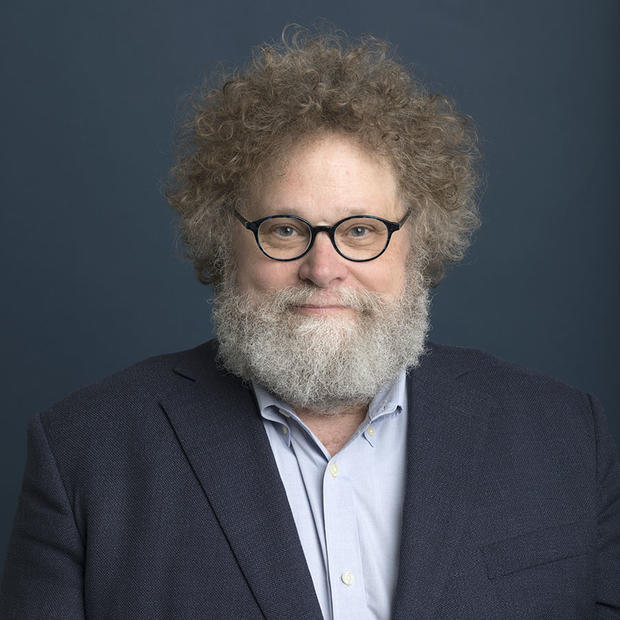What follows is a nonexhaustive review of some of our region’s experience with violent protests or clashes. Some have arguably yielded positive results, while others reflect tragedy, human cruelty and senseless destruction. Many of society’s faults and fault lines featured here remain intact. The violence gets attention, and today it is being exposed, broadcast and tweeted as never before. The smartphone is now an essential part of protest documentation. The historical record is another window that can provide context and background for what we are seeing today.
The following is offered in that spirit.
Race riots
Violent removals of Chinese residents in Tacoma and Seattle
In 1885, the mayor of Tacoma, Jacob Weisbach, led a regional effort to exclude all Chinese immigrants from Western Washington, an effort largely planned during a regional anti-Chinese meeting in Seattle. Tacoma ordered the Chinese population out of town and rounded up hundreds who did not obey. A mob armed with clubs and guns abused them, force-marched them to a train, then razed and burned their homes and businesses. The effort, led by the city's civic leaders, was so cruel and efficient that such tactics became known as the “Tacoma method.”
In 1886, Seattle tried to do the same. Inspired by the murder of Chinese hop pickers in Issaquah and stirred by the Knights of Labor, who wanted the Chinese expelled for supposedly taking jobs from whites, a large mob brutally herded the majority of the city’s Chinese residents to a wharf, where they were to be placed on a steamship bound for San Francisco. One hundred or so Chinese residents were not able to get onboard and, under protection of a phalanx of Seattle Home Guards, were escorted back toward Chinatown, but they were confronted on the way by an angry white mob. They fought with fists and clubs until finally the guards fired their rifles into the crowd, killing one rioter and injuring several more. Martial law was declared, U.S Army troops were called in to patrol the city. The soldiers remained for months to ensure calm, but only a small Chinese population remained in Seattle following the violent expulsion.
Anti-Chinese sentiment had been festering on the West Coast for years. They were targets of the Ku Klux Klan in California and Oregon going back to the late 1860s, but it was the 1882 Chinese Exclusion Act that fueled the forced removal. Signed by President Chester A. Arthur, the racist law outlawed immigration of Chinese laborers. Thousands of records of Chinese immigrants from that era are stored in the federal archives at Sand Point in Seattle. The Trump administration has slated the archives facility to be closed and its contents removed, but much of that history is being recovered by volunteer researchers.
Soldiers vs. prisoners of war at Fort Lawton
In 1944, Black soldiers stationed at Fort Lawton, now part of Discovery Park, were upset that Italian prisoners of war held there received more privileges than Black soldiers because the prisoners were white, even though they were enemies at war with the United States. A riot broke out — perhaps one stoked by white military police officers — and dozens were hurt, including an Italian POW who was lynched. Over 40 Black soldiers were charged with riot or manslaughter and court martialed, despite a lack of evidence. That railroading resulted in 28 soldiers being convicted and sentenced to hard labor, and ultimately dishonorably discharged. Research into the case by Seattle author Jack Hamann helped uncover and correct the injustice of unfair charges, secret trials and a military cover-up. It remains unknown who lynched the Italian prisoner, but white soldiers were also suspected, though not charged. The convicted soldiers were formally acquitted in 2008, and the Army issued an apology in a formal ceremony. Unfortunately, only two of the men were still living by the time they were acquitted.
The aftermath of Martin Luther King Jr.'s assassination
In the spring of 1968, Dr. Marin Luther King, Jr. was assassinated. Mourning was widespread nationally, and in Seattle vigils were held across the city. A wave of social unrest ensued, including violent protests. One positive outcome here was that the city of Seattle finally overcame local resistance to open housing, allowing people of any race to buy or rent property in the city. The policy had been put to a vote in 1964 and, disturbingly, lost by a 2-to-1 margin. But motivated by the potential for greater unrest and under mounting pressure from civil rights activists in the Black community, the city council finally passed it into law three weeks after King’s death. Shortly before King’s murder, there was a peaceful sit-in at Franklin High School in South Seattle protesting the treatment of Black students. It was the first of its kind in a city high school. The day King died, that April, some of the Franklin sit-in activists were arrested for unlawful assembly and accused of “inciting riot.” The student demonstrators, who included Larry Gossett, Aaron Dixon and Carl Miller, were imprisoned and forced to stand trial. In July, they were convicted and sentenced to six months in jail for a gross misdemeanor — a sentence that was clearly a gross injustice. Outrage triggered two days of rock throwing, lootings and overturned cars in the Central District. Police responded with tear gas. Central District leaders, including the Black Panthers, attempted to restore order. Later that month, violence erupted again when Seattle police raided the Black Panther offices. The anger of that summer stemmed from the chronic, systemic mistreatment of Black people by the police and justice system. Protests over injustice and the treatment of the Black community continued.
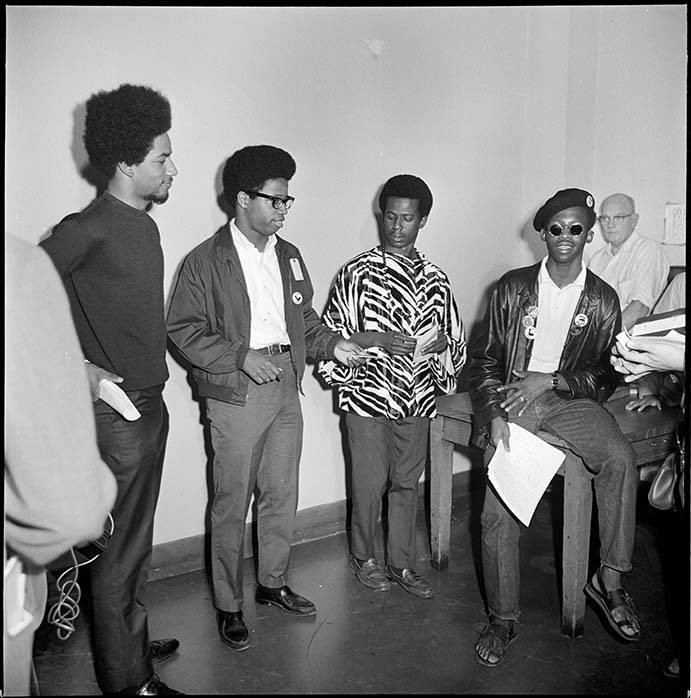
Rodney King riots of 1992
In May 1992, a jury acquitted four Los Angeles police officers of beating unarmed Rodney King. The vicious incident was caught on video by a private citizen who lived nearby. It was later broadcast on local TV and went viral. The verdict caused major rioting in LA, but also disturbances in Seattle, where protesters and anarchists set fires, threw rocks and trashed parts of downtown and Capitol Hill. This would not be the last time an injustice against African Americans would motivate such an event.
Labor riots
Potlatch mayhem of 1913
In 1913, Seattle marked its annual civic festival, the Golden Potlatch, in which white businessmen appropriated Northwest First Nation’s attire to celebrate the city, its industry and its imperial domain extending to Alaska. A woman named Annie Miller took to Occidental Avenue, in Pioneer Square, to advocate for women’s suffrage. Accounts vary, but she may or may not have talked about socialism, or disparaged the military. She was not an Industrial Workers of the World union rabble-rouser, as the press claimed. A drunken sailor apparently objected to her speech and grabbed or assaulted her. A spectator defended Miller, a fistfight followed and more sailors and soldiers joined in, resulting in an all-out brawl over political speech. The local papers fanned the flames, especially The Seattle Daily Times, whose publisher, Alden Blethen, claimed a left-wing revolution was at hand, and the coverage fomented further violence. The following night, rioters by the hundreds, perhaps thousands, many of them military personnel, continued to terrorize the streets, destroying the headquarters of the IWW and ransacking the offices of local socialists. The progressive mayor, George Cotterill, outraged by the Times’s inflammatory coverage, sent the police to stop the newspaper’s publication. A writer for a Seattle socialist paper described Blethen as “an aged lunatic tottering toward a mad house of bedlam and energetic fur, lashing himself with his wild imaginings and stinging himself to death with the noisome venom of his own hate.” Nevertheless, a judge overruled Cotterill and the presses rolled. Martial law was declared and the rioting quelled.
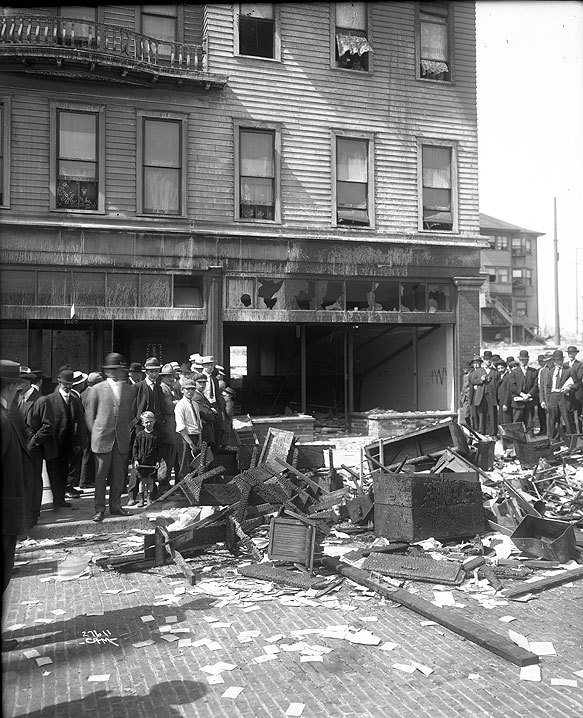
The Everett Massacre of 1916
A strike against Everett’s shingle mills raised tensions in “the City of Smokestacks” in 1916. The strike was settled, but one mill held out and members of the radical Industrial Workers of the World lent their support to the workers. The city had outlawed public speaking about socialism, so the Wobblies wanted to make a protest point. Two steamers full of activists headed to Everett, but the Snohomish County sheriff and an armed deputized posse met the first. Someone fired a shot, then the workers standing on the deck of the boat exchanged gunfire with those on the dock. The gunfight left two deputies dead and 20 sheriff’s men wounded. At least five Wobblies were killed, perhaps as many as a dozen, and 27 were wounded. Seventy-four Wobblies were arrested when they arrived back in Seattle, but only one was charged with murder (he was later acquitted). The governor summoned the National Guard to both cities to quiet things down. (The composer Wayne Horvitz later wrote an opera about the massacre, which he called, Smokestack Arias.)
The 1919 Centralia Tragedy
A violent clash between American Legionnaires and Wobblies occurred in Centralia in 1919 on the first anniversary of the World War I armistice. The Industrial Workers of the World was active in the mills and lumber camps in the area. The union's headquarters in town had been shut down by locals, but they reopened. A parade of Legionnaires stopped in front of its offices in an old hotel, at which point some in the parade broke ranks and charged the Wobblies’ hangout. Shooting started. The armed IWW members claimed self-defense, while the marchers claimed they were ambushed. Four Legionnaires were killed, a Wobbly was lynched, and the rest were rounded up and tried for murder. Many were convicted on slim evidence in an unfair trial and given lengthy sentences. The lynch mob was never brought to justice.
An anarchist bomb goes off
By the spring of 1919, Seattle Mayor Ole Hanson had steered the city through the Spanish flu pandemic and the Seattle General Strike, which was a peaceful shutdown of the entire city. There was no rioting or violence, but Hanson exaggerated the threat of “Bolshevism.” He became a national hero for standing up to the so-called Red menace, as people feared that general strikes would proliferate around the country and Russian-style revolution would follow. It did not. But that publicity seems to have had a downside for Hanson. In April, his office received a package. Hanson was out of town and his secretary opened it upside down — inside was a bomb that did not explode. Its arrival had been timed for May Day. An anarchist group had sent bombs to dozens of prominent Americans — politicians, businessmen and law enforcement officials. Some months later, Hanson resigned from office to travel the country to enjoy a heady and lucrative 15 minutes of fame as a hero of anti-communism. He later moved to California.
Communist bashing on Skid Road
The Great Depression saw lots of social unrest, demonstrations and crackdowns on radicals and the unemployed. Many jobless workers turned to radical groups for solutions. A painting of an incident, dated May 1, 1930, epitomizes the era. It shows police attacking a crowd of communist demonstrators at the corner of Occidental Avenue and Washington Street, in the heart of Skid Road. Police on horseback seem to be brutally breaking up a gathering using nightsticks and trampling demonstrators. The painter was a man named Ronald Debs “Ray” Ginther, who grew up in a radical family — his middle name was for Socialist Eugene Debs — and who documented life during the Depression, including police harassment and Hooverville, according to University of Washington history professor James Gregory. His paintings were based on what he witnessed, though some were not painted until decades later. I couldn’t find press accounts of a May 1 event that year, but a short article in The Seattle Times a couple of months earlier, in March 1930, has all the features portrayed here. A parade of 200 communists marched at noon, attracting some 5,000 spectators. “The parade had hardly gone 50 feet before squads of mounted patrolmen, motorcycle men and officers swinging nightsticks broke it up,” the paper reported. Twelve men were arrested in the bloody brouhaha. Cracking down on “Reds,” labor groups, the homeless and the jobless was almost routine for the police and authorities during the Depression in Seattle.
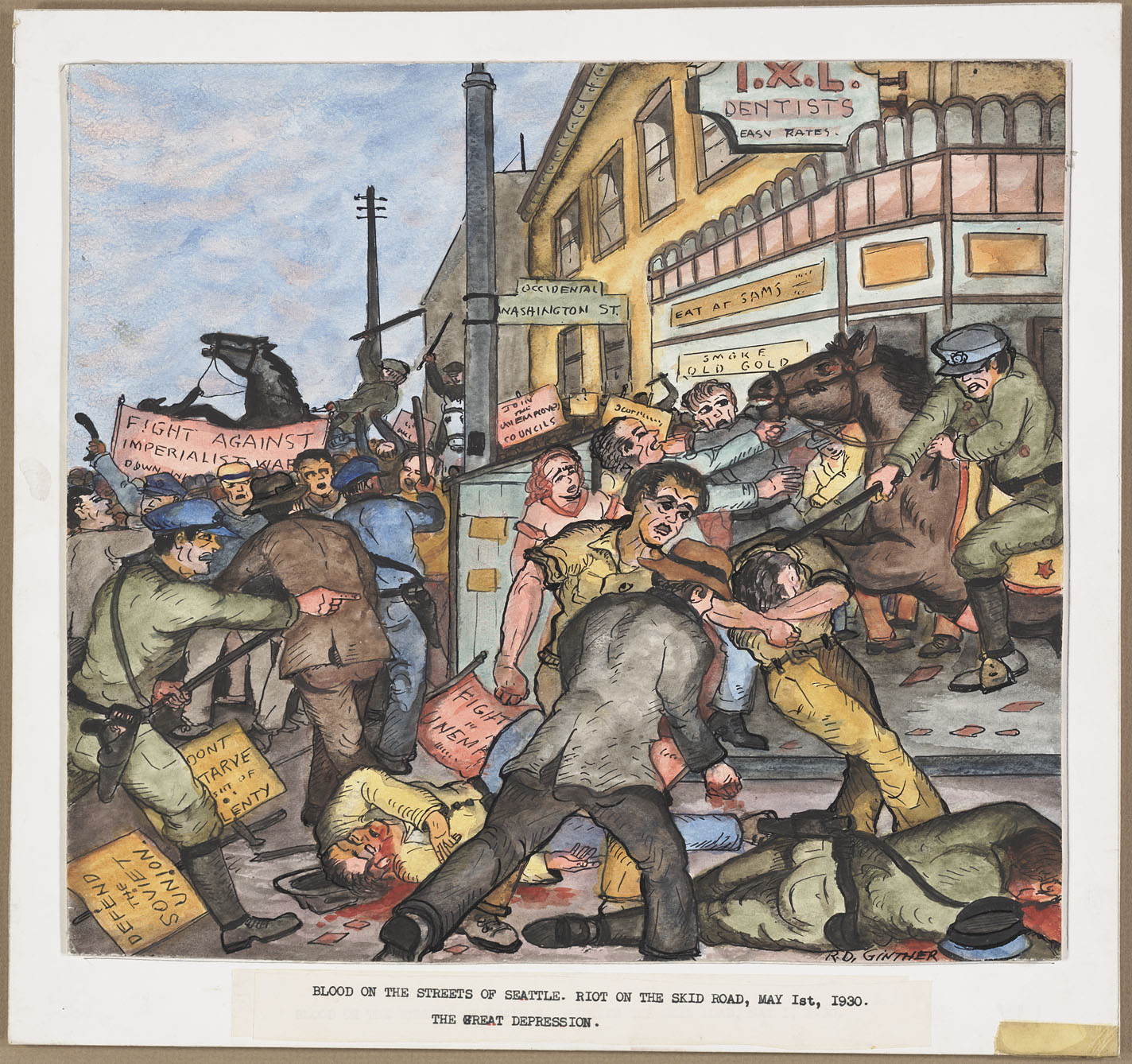
The waterfront riots of 1934
A massive, 83-day strike of West Coast longshoremen was called in the summer of 1934 and accompanied by violence in cities including San Francisco, Tacoma and Seattle. It is sometimes referred to as “the War on the Docks.” Fights took place between union members and replacement workers — also known as scabs — who were forced to run a gauntlet while strikers brutally beat them from either side. Crowds of teamsters and longshoremen also attacked scabs and strikebreakers in downtown using brass knuckles and two-by-fours. A company guard on one of the Elliott Bay piers shot and killed a striker. Newsreel footage of a riot in Tacoma has eerie similarities to images of today’s demonstrations, as union members threw back canisters of tear gas tossed by heavily armed police. (This short film is worth watching). The strike brought shipping to a standstill; only one vessel managed to leave the Port of Seattle during the entire strike. A major battle occurred at Smith Cove, near the Magnolia Bridge, where strikers and police clashed. The police used mounted officers who were said to charge like cavalry with clubs and gas masks to run down strikers. The strike was eventually settled in arbitration.
When protests turned violent
Anti-war demonstrations
Seattle was a hotbed of opposition to the Vietnam War. Historian and Historylink.org co-founder Walt Crowley wrote in his memoir of the ’60s, Rites of Passage, that Seattle ended the year 1969 “with the dubious distinction of being the nation’s ‘bombing capital,’ ” with some 69 explosions or arson fires. (Though not all were politically motivated, many were.) Anger boiled over again in May 1970 after the U.S. invasion of Cambodia, the killing of student protesters at Kent State in Ohio and, shortly after, the gunning down of students at Jackson State in Mississippi whose only crime was being Black. On May 1, some 1,000 demonstrators protested downtown, and an ROTC building on the University of Washington campus was vandalized. Other campus fires ensued. Students called for a strike, and 7,000 of them poured onto Interstate 5, moving from the University District toward downtown, blocking the freeway and infuriating drivers. The next day, 10,000 students blocked I-5 again and police fired tear gas. Over the next few days students were beaten in the U District by vigilantes, 15,000 marched on downtown and ongoing acts of vandalism, disruption and sabotage continued at the university. (Crowley’s book provides an extensive timeline of Seattle anti-war activity in this period and how it tracked with national events.)
Turtles and Teamsters at the 1999 WTO protests
In November 1999, the World Trade Organization brought its major ministerial conference to Seattle, a pro-trade city. But for at least a year in advance, labor, environmental and other activists planned to use the occasion to shut down the WTO meeting through direct action to protest corporate globalization. Tens of thousands of protesters turned out along with thousands of delegates, government officials and representatives of worldwide nongovernmental organizations, or NGOs. On Nov. 30, marchers — some 40,000 to 60,000 — clogged downtown Seattle, gridlocking the city and leading to the successful shut down of the conference. At one point, drums filled the air, an anarchist marching band played and protesters carried huge paper puppets on their shoulders, while other dressed as endangered sea turtles, giving the protest a Woodstock charm. Then, the Seattle police decided to get tough and fired pepper gas and rubber pellets into a crowd blocking the intersection at Sixth Avenue and Union Street. Black-clad anarchists suddenly turned to smashing windows and setting dumpster fires. So began the so-called Battle of Seattle (it even spawned a Hollywood movie by the name). Downtown was shut down, a state of emergency was declared, the National Guard was called in and arrests were made. In terms of size, it was the biggest mass protest in Seattle history, and burnished the city’s reputation as a radical town, despite the prosperity it received from trade. The protest turned into a weeklong series of clashes between demonstrators and the police. Some anniversaries of the protests have repeated confrontations on a smaller scale.
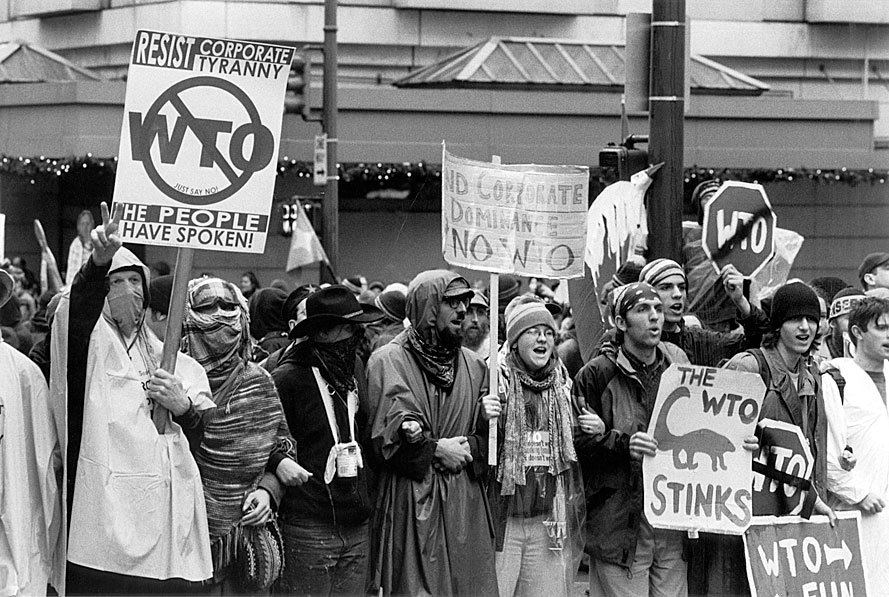
Annual May Day parades
Much of the anarchist energy of the “Battle of Seattle” was transferred into the next century, with annual parades and protests increasingly taken over by black-clad protesters intent on mayhem. It has now become a yearly event in which parades of progressives, union supporters and immigrant and social justice advocates are often overshadowed by media coverage of anarchist vandalism, property destruction and street battles with police. Eli Sanders of The Stranger wrote a piece about the evolution of May Day since 2012 that gives a good picture of what it has become.
Yiannopoulos madness
In 2017, a year into Donald Trump's presidency, a University of Washington Republican group invited a conservative provocateur and darling of the so-called alt-right, Milo Yiannopoulos, to speak at on campus. Yiannopoulos was a former editor of the right-wing website Breitbart. Protesters, including antifa, and others massed outside Kane Hall in Red Square, with crowds of Yiannopoulos supporters. Sparks flew, pushing and shoving and mini-melees occurred. Despite extensive police presence, an anti-fascist demonstrator was shot in an altercation with a conservative couple outside the venue. (They claimed self-defense.)
Youth riots
Alki Beach riot of 1969
Sometimes riots occur after sports events, parties or public events, or for no clear reason. Sometimes, people drink too much and decide to blow off steam. On Aug. 11, 1969, a disturbance occurred at a rock concert at Alki Beach in West Seattle, which escalated when people claimed police harassment. A Seattle Police Department vehicle was set ablaze as officers arrested two men drinking beer in the park. Hundreds in a crowd of some 2,000 youths brawled with police, who fought with clubs and gas that made people sick. Rocks were thrown and arrests were made in the three-hour fight. Complaints poured in over excessive force used by police, including the indiscriminate use of gas. Some canisters were fired into neighboring homes and groups of innocent bystanders.
Eruption on The Ave
Right after the Alki blowup of 1969, the University District erupted over the course of two nights when hippies and teens ran wild in the streets, looting shops and fighting with cops. At one point a group of theatergoers, exiting a performance of a Shakespeare play, was engulfed in the wild scene, creating more chaos and confusion. Some rioters were angry with police harassment over drug use and possession in the U District. Rebellion against authority seemed to be a theme. Police said some of the same youths from Alki also rioted on the Ave. Among the arrest charges were littering, resisting arrest and using foul language. The riots became an issue in the mayor’s race, with Democrat Wes Uhlman urging full prosecution of “ringleaders” and Republican Ludlow Kramer advocating the creation of new youth programs.
Mardi Gras mayhem of 2001
A worse event, because it took a life, was the Mardi Gras riots in February 2001 in Pioneer Square. Some 2,000 partiers were out of control on Saturday, the first night of celebrations, throwing rocks and tussling with police. A bigger and more unruly crowd on Fat Tuesday took over Pioneer Square — some 4,000 revelers and 350 police. Again the crowd got out of control, people were assaulted, rocks and bottles thrown, cars overturned, windows broken, and businesses vandalized and looted (here’s some graphic footage). A young man, Kristopher Kime, tried to rescue a woman in the melee and was beaten to death. The police broke it up with tear gas and batons. Scores were injured before the police took charge. They were criticized for not intervening in the riot sooner.
This is by no means a comprehensive list of violent demonstrations, protest and riots, and it leaves out scores of systemic violence that occurred throughout the 19th and 20th century. This history is meant to look at moments during the region’s urban era when the streets exploded in violence and destruction for a variety of reasons and causes.
Blackpast.org, based in Seattle, is an excellent resource on African American history. For those interested in deep-diving on the history of race riots, for example, it offers a timeline that includes links to its articles on American events dating back to the 1600s. The website, founded by the University of Washington professor Quintard Taylor, covers the Pacific Northwest extensively, but is also international in scope. It is an invaluable resource, especially in these times.
I also want to acknowledge the great work done by Seattle’s Historylink.org, which covers so much Northwest history so well, and the University of Washington, whose scholars and students have contributed much needed scholarship about our labor and civil rights history. The online resources of the Seattle Public Library are also a tremendous help for researchers. Finally, I want to shout out the the digital archives of the Washington State Historical Society, which allows free access to the public and provided some of the remarkable historic photographs, as did the digital collection of the Museum of History and Industry.
These are just a few of the excellent resources that preserve and communicate our history, and which I have used in compiling parts of this article.
(Full disclosure: I have donated money to Blackpast, Historylink, the Seattle Library Foundation, and MOHAI, and am a member of the Washington State Historical Society)"


